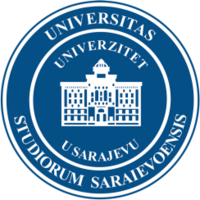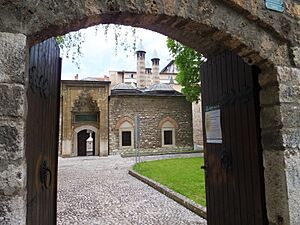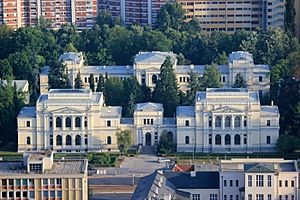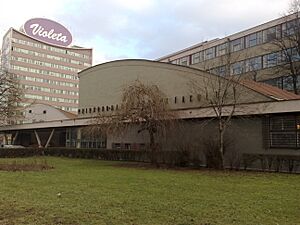University of Sarajevo facts for kids
|
Univerzitet u Sarajevu
Sveučilište u Sarajevu Универзитет у Сарајеву |
|||||||||||||||||
 |
|||||||||||||||||
| Type | Public | ||||||||||||||||
|---|---|---|---|---|---|---|---|---|---|---|---|---|---|---|---|---|---|
| Established | 2 December 1949 (1537 as an Islamic madrasa) |
||||||||||||||||
| Endowment | $247.9 million (2020) | ||||||||||||||||
| Budget | $107.8 million (2020) | ||||||||||||||||
| Rector | Prof. dr. Tarik Zaimović | ||||||||||||||||
|
Academic staff
|
1,636 | ||||||||||||||||
|
Administrative staff
|
990 | ||||||||||||||||
| Students | 23,127 (2021) | ||||||||||||||||
| Location | , | ||||||||||||||||
| Campus | Urban | ||||||||||||||||
| Colors | Blue and white
|
||||||||||||||||
| Affiliations | European University Association | ||||||||||||||||
| Website | |||||||||||||||||
| University rankings | |
|---|---|
| Regional – Overall | |
| QS Emerging Europe and Central Asia | 162 (2022) |
The University of Sarajevo is a public university located in Sarajevo, Bosnia and Herzegovina. It is the largest and oldest university in the country. Its history goes back to 1537, when it started as an Islamic school called a madrasa.
Today, the university has 20 main departments (faculties), three academies, and three theology departments. As of 2021, it had 23,127 students. This makes it one of the biggest universities in the Balkans. Since it officially opened in 1949, over 122,000 students have earned their first degrees. Also, 3,891 students have received master's degrees, and 2,284 have earned doctorate degrees in 45 different subjects. It is known as the most respected university in Bosnia and Herzegovina. More than 1,000 teachers and researchers work there.
Contents
- History of the University of Sarajevo
- University Partnerships
- Main Goals
- How the University is Organized
- University Leaders (Rectors)
- Famous People from the University
- See also
History of the University of Sarajevo
Early Beginnings: Ottoman Period (1500s)
Before the modern University of Sarajevo was created, the first higher education schools in Sarajevo began in the 1500s. These schools were started during the time of the Ottoman Turks. In 1537, Gazi Husrev Bey opened an Ottoman higher education institute, which was a madrasa.
Growth and Development: Austria-Hungary and First Yugoslavia (Early 1900s)
The university as we know it today, with its modern, non-religious approach, grew during the Austro-Hungarian rule in Bosnia and Herzegovina. During this time, many important schools and cultural places were built. For example, the National Museum of Bosnia and Herzegovina was established and is still active today.
The university continued to grow after World War I and even during World War II. New schools and institutes were added. This included the Faculty of Agriculture and Forestry in 1940 and the Medical Faculty in 1944. The Medical Faculty reopened in 1946. The Faculty of Law and the Teacher Training College also opened. In 1948, the Faculty of Agriculture and Forestry was re-established.
Official Establishment and Post-WWII Expansion
Official Opening (1949–1955)
In 1949, the Engineering Faculty was opened. On December 2, 1949, the University of Sarajevo was officially established when its first leader (rector) was appointed. The first stage of setting up the university was finished with the opening of the Faculty of Humanities in 1950 and the Faculty of Economics in 1952.
University Growth (1955–1970)
The second stage of the university's growth happened between 1955 and 1969. During this time, the university became more recognized. New higher education institutions were opened. The university also started offering postgraduate studies, which are advanced studies after a first degree.
Expanding Influence (1970–1982)
From 1970 to 1982, even more higher education institutions were added to the university. The university also became more involved in international academic work. It helped set up new universities in Banja Luka, Mostar, and Tuzla.
Challenges and Changes (1982–1992)
Between 1982 and 1992, some scientific research activities were moved away from the university. This caused problems because the connection between teaching and research became weaker. This led to a lower quality of education. Also, too many students were allowed to enroll, which made studies less effective.
Resilience During Conflict (1992–1995)
The period from 1992 to 1995 was very difficult. The university's buildings and equipment were badly damaged during the Bosnian War and the siege of Sarajevo. Despite these challenges, the university continued to operate. Teachers, staff, and students showed great dedication and courage. They kept the university running as a way to resist the war and support freedom and democracy.
Post-War Renewal (1996–Present)
Since 1996, the University of Sarajevo has been working on rebuilding and improving itself. This includes repairing damaged buildings and replacing equipment. They are also working on a new university campus. While much progress has been made, the university is still working to reach its full potential from before the war. Many academics who worked there before the war did not return. The quality of studies is slowly getting better, partly because of new education standards called the Bologna Process.
Many international groups, like the European University Association and the European Union, are helping the university with its renewal.
University Partnerships
The University of Sarajevo has partnerships with more than 120 universities. These partners are located in Europe, the US, Canada, and the Middle East.
Main Goals
The main goal of the university today is to improve the quality of its studies. It aims to be a modern university that meets European standards. It wants to be a respected representative of Bosnia and Herzegovina on the world stage. It also promotes the country's history, culture, science, and art, as well as those of Southeastern Europe.
How the University is Organized
The University of Sarajevo has 32 main departments, academies, and colleges. These are further divided into 6 academic groups and other programs.
Main Schools and Faculties
- School of Economics and Business
- Academy of Fine Arts
- Academy of Performing Arts
- Faculty of Architecture
- Faculty of Electrical Engineering
- Faculty of Criminal Science
- Faculty of Political Science
- Faculty of Sport and Physical Education
- Faculty of Traffic Engineering and Communications
- Faculty of Humanities
- Faculty of Pharmacy
- Faculty of Civil engineering
- Faculty of Mechanical engineering
- Medical Faculty
- Music Academy
- College of Teacher education
- Faculty of Agriculture
- Faculty of Law
- Faculty of Science and Technology
- Faculty of Natural sciences and Mathematics
- Faculty of Dental medicine
- Faculty of Forestry
- Faculty of Veterinary medicine
- Faculty of Health Studies
Other Important Members
- Faculty of Islamic studies
- Faculty of Catholic Theology
- Faculty of Public Administration
Research Institutes
- Institute of History
- Institute for Researching Crimes against Humanity and International Law
- Institute for Genetic Engineering and Biotechnology
- Oriental Institute
- Students Center Sarajevo
- Institute for Social Research
University Leaders (Rectors)
- Vaso Butozan (1949–1950; 1952–1956)
- Drago Krndija (1950–1952)
- Edhem Čamo (1956–1960)
- Aleksandar Trumić (1960–1965)
- Fazlija Alikalfić (1965–1969)
- Hamdija Ćemerlić (1969–1972)
- Zdravko Besarović (1972–1977)
- Arif Tanović (1977–1981)
- Božidar Matić (1981–1985)
- Ljubomir Berberović (1985–1988)
- Nenad Kecmanović (1988–1991)
- Jusuf Mulić (1991–1993)
- Faruk Selesković (1993–1995)
- Nedžad Mulabegović (1995–2000)
- Boris Tihi (2000–2004)
- Hasan Muratović (2004–2006)
- Faruk Čaklovica (2006–2012)
- Muharem Avdispahić (2012–2016)
- Rifat Škrijelj (2016–2024)
- Tarik Zaimović (2024–present)
Famous People from the University
Many notable people have studied or taught at the University of Sarajevo.
Alumni (Former Students)
- Abdulah Nakaš, a well-known surgeon in Sarajevo
- Adela Jušić, a modern visual artist
- Ademir Kenović, a movie director and producer
- Aleksandar Hemon, a writer
- Alija Behmen, former mayor of Sarajevo
- Alija Izetbegović, the first Chairman of the Presidency of Bosnia and Herzegovina
- Bakir Izetbegović, former member of the Presidency of Bosnia and Herzegovina
- Benjamin Djulbegovic, a medical expert
- Benjamina Karić, the current mayor of Sarajevo
- Beriz Belkić, former member of the Presidency of Bosnia and Herzegovina
- Bisera Turković, former foreign minister
- Boris Nemšić, a business leader in telecommunications
- Božidar Matić, former chairman of the Council of Ministers
- Branko Đurić, an actor and musician
- Dejan Milošević, a theoretical physicist
- Denis Bećirović, a member of the Presidency of Bosnia and Herzegovina
- Denis Zvizdić, former Chairman of the Council of Ministers
- Dritan Abazović, former Prime Minister of Montenegro
- Edvin Kanka Ćudić, a human rights activist
- Elmedin Konaković, foreign minister and former Premier of Sarajevo Canton
- Hatidža Hadžiosmanović, former president of the Constitutional Court
- Heather McRobie, a writer
- Ivica Osim, a famous footballer and coach
- Jasmila Žbanić, a film director
- Jasmin Geljo, an actor
- Jasmin Imamović, former mayor of Tuzla
- Jelena Silajdžić, a human rights activist
- Kemal Ademović, a politician
- Kornelije Kovač, a composer
- Krešimir Zubak, former member of the Presidency of Bosnia and Herzegovina
- Mario Nenadić, former Premier of Sarajevo Canton
- Mato Tadić, former president of the Constitutional Court
- Maya Sar, a singer
- Mile Akmadžić, former Prime Minister
- Miljenko Jergović, a writer
- Mirko Šundov, Chief of General Staff of the Croatian Armed Forces
- Neda Ukraden, a folk singer
- Omer Halilhodžić, an automotive designer
- Predrag Finci, a philosopher and essayist
- Radmila Hrustanović, former mayor of Belgrade
- Radovan Karadžić, a former politician
- Radovan Višković, a politician
- Rasim Ljajić, former deputy Prime Minister of Serbia
- Rifat Hadžiselimović, a geneticist
- Safet Isović, a prominent singer
- Seada Palavrić, a member of the Constitutional Court
- Selmo Cikotić, former minister of Security and Defence
- Semiha Borovac, former mayor of Sarajevo
- Senad Bašić, an actor
- Slavo Kukić, a sociologist
- Sulejman Tihić, former member of the Presidency of Bosnia and Herzegovina
- Sven Alkalaj, former foreign minister
- Šefik Džaferović, former member of the Presidency of Bosnia and Herzegovina
- Valerija Galić, president of the Constitutional Court
- Vlado Pravdić, an organist
- Zdravko Čolić, a pop singer
- Zlatko Lagumdžija, former Chairman of the Council of Ministers
- Zlatko Topčić, a writer
- Zukan Helez, defence minister
- Željka Cvijanović, a member of the Presidency of Bosnia and Herzegovina
- Željko Komšić, a member of the Presidency of Bosnia and Herzegovina
- Živko Radišić, former member of the Presidency of Bosnia and Herzegovina
Faculty (Teachers and Staff)
- Adil Osmanović, former minister of Civil Affairs
- Alija Behmen, former mayor of Sarajevo
- Bogić Bogićević, former member of the Presidency of Yugoslavia
- Danis Tanović, an Oscar-winning director
- Dejan Milošević, a theoretical physicist
- Denis Zvizdić, former chairman of the Council of Ministers
- Ejup Ganić, former prime minister
- Hamdija Pozderac, president of SR Bosnia and Herzegovina
- Haris Silajdžić, former member of the Presidency of Bosnia and Herzegovina
- Haris Pašović, a director
- Mirko Šarović, former member of the Presidency of Bosnia and Herzegovina
- Nenad Kecmanović, former member of the Presidency and rector of the university
- Predrag Finci, a philosopher and essayist
- Senad Hadžifejzović, a journalist and TV host
- Sifet Podžić, former minister of Defence
- Sredoje Nović, former minister of Civil Affairs
- Tomislav Dretar, a writer and philosopher
- Vojislav Šešelj, former deputy Prime Minister of Serbia
- Zdravko Grebo, founder of the Open Society Foundation
- Zlatko Lagumdžija, former Chairman of the Council of Ministers
- Zoran G. Jančić, a pianist
See also
 In Spanish: Universidad de Sarajevo para niños
In Spanish: Universidad de Sarajevo para niños
- List of Islamic educational institutions
- Balkan Universities Network
- List of universities in Bosnia and Herzegovina
- Education in Bosnia and Herzegovina
- Lists of universities and colleges
- List of split up universities









